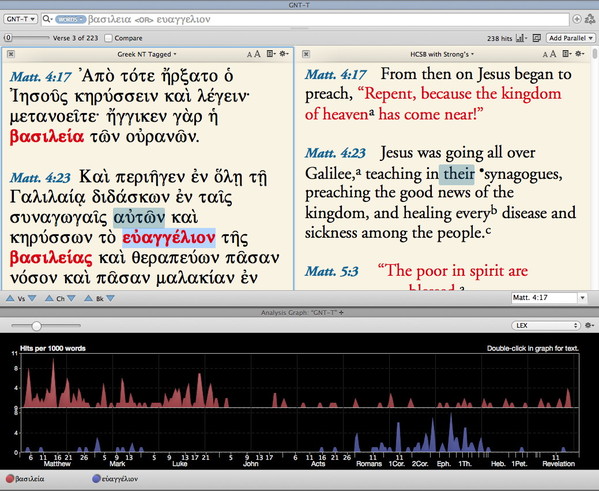Last week, I was busy exhibiting Accordance at the Gospel Coalition’s National Conference here in Orlando. During a few of the sessions, I stepped away from the booth to listen to the speakers. One of these was a panel discussion entitled “Did Jesus Preach the Gospel?” In it Don Carson, Kevin DeYoung, Tim Keller, and John Piper discussed the distinction some interpreters make between the “gospel” that Paul preached and Jesus’ own emphasis on the coming of the “kingdom.”
It was a lively, interesting, and collegial discussion. The speakers all agreed that the Pauline epistles use the word “gospel” more frequently than the Gospels themselves, and that the Gospels use the word “kingdom” more frequently than Paul. But they disagreed with the notion that we misread the Gospels by reading them through a Pauline lens, along with the related notion that we ought instead to read Paul through the interpretive lens of Jesus’ message about the coming of the kingdom. They argued that the difference in vocabulary between the Gospels and Paul does not indicate two conflicting messages, and that any attempt to give one priority over the other represented the formation of a canon within a canon. In fact, Carson pointed out that the language of “kingdom” is likewise infrequent in the Gospel of John, so this line of reasoning leads to the Synoptic Gospels becoming a “canon within a canon within a canon.” He then pointed out that the belief that Matthew and Luke were dependent on Mark ends up leading to Mark becoming the “canon within a canon within a canon within a canon!”
All this made me curious about the data on which they were basing these observations, and of course, Accordance makes gathering that data a breeze. So when the session was over I returned to our booth and searched the Greek New Testament for βασιλεια <OR> ευαγγελιον. I then chose Analysis Graph from the Stats and Graphs icon of the Search tab.
The Analysis Graph shows the frequency of occurrence of various criteria across your search range. By choosing Lex (for lexical form) from the pop-up menu at the top right, I can compare the use of βασιλεια (kingdom) and ευαγγελιον (gospel) throughout the New Testament.
Looking at this graph, we see that “kingdom” is indeed far less frequent in John than in the other gospels. Yet we also see that while “kingdom” appears frequently in Luke, it is relatively infrequent in the other Lukan book of Acts.
Another interesting thing to note is how much more frequent “kingdom” is in Matthew and Luke than in Mark. It would appear from this that rather than Mark, it is the hypothetical source known as Q, which allegedly contained the sayings of Jesus common to Matthew and Luke, which would comprise the “canon within a canon within a canon within a canon” which Carson mentioned.
With respect to “gospel,” it certainly does receive more attention in the Pauline corpus than anywhere else, and is almost completely absent from the General Epistles and the writings of John (for whom “kingdom” isn’t a major emphasis either). Interestingly, of all the Evangelists, Mark is the one who places the greatest emphasis on “gospel.” Matthew, on the other hand, is interesting because almost all of his uses of the term refer to “the gospel of the kingdom.”
I will leave it to the scholars to draw meaningful conclusions from all these observations, and of course, this search might need to be supplemented with searches for other related terms. Still, I hope you can see how analytic tools like this can make it easy to spot phenomena in the Bible worth exploring.
What about you? Can you spot any interesting aspects of the above graph which I’ve failed to mention?


